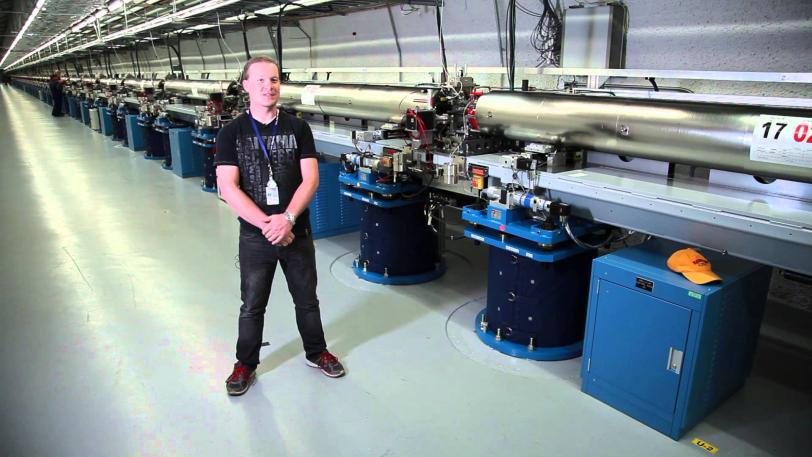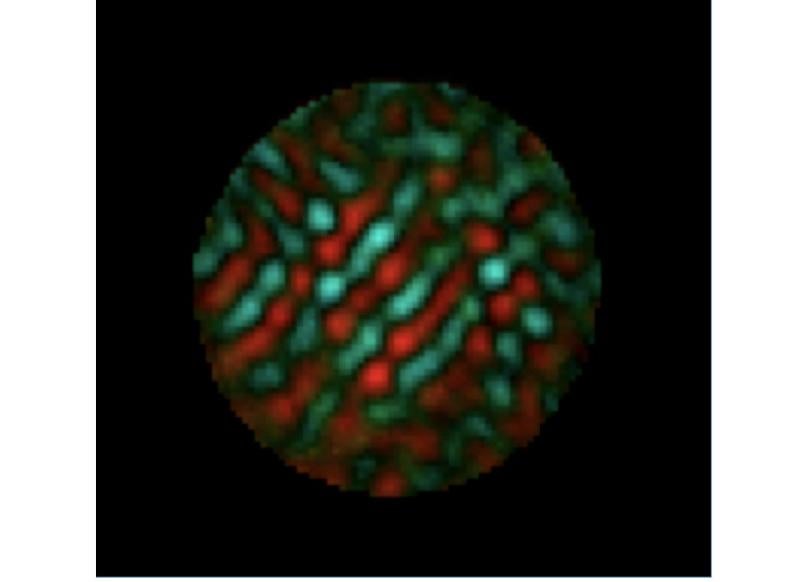Tools of the Trade: New X-ray Microscopy Technique Images Magnetic Nanostructure
A new X-ray technique for producing instantaneous nanoscale images of the magnetic polarity in materials has been demonstrated by SLAC scientist Joshua Turner.
By Mike Ross
A new X-ray technique for producing instantaneous nanoscale images of the magnetic polarity in materials has been demonstrated by SLAC scientist Joshua Turner. Such a capability is important for understanding the basics of magnetism and how new “spintronic” materials, which use the "up-down" spins of electrons to furnish the "on-off" instructions currently provided to electronic devices by plus and minus electric charges, would behave in future energy-efficient computers, digital memories and data storage devices.
The new method combines aspects of two existing X-ray techniques: one that determines 3-D molecular arrangements with another that is sensitive to magnetic structures.
“Biologists can use coherent X-ray techniques to calculate the electronic structure of complicated molecules from the pattern of X-rays diffracted off their electrons,” Turner said. “But it turns out that the formula they use actually contains more parts that relate to the electron spin of magnetic atoms, such as iron and cobalt. Since biologists rarely work with magnetic molecules, they usually ignore the other parts of the equation. But because electron spin is the source of magnetism, we can use the full formula to determine both the location and magnetic orientations of groups of atoms.”
Turner came to that realization three years ago, when he was nearly finished with graduate school at the University of Oregon. To pursue his idea, he took a postdoctoral research position with Chris Jacobsen at Stony Brook University in New York, where in 1999 scientists had first demonstrated the “lensless” X-ray diffraction technique that biologists use. This technique requires a coherent X-ray beam, but uses calculations instead of lenses to determine molecular structures from diffraction patterns. Among Turner’s mentors was emeritus faculty member Richard Gambino, a magnetic materials expert and National Medal of Technology winner. The key step in Turner’s new technique is in interpreting the complex resonant X-ray scattering information from the calculations which reveal the magnetic information.
After three years of trials, failures and improvements, Turner and colleagues succeeded earlier this year. They imaged a cobalt alloy sample with and without an external magnetic field that was more than 600 times stronger than Earth’s. The difference between the two views revealed in great detail the magnetic polarities throughout the alloy. Turner performed his experiments at Lawrence Berkeley National Laboratory’s Advanced Light Source. The results were published last month in the physics journal, Physical Review Letters.
This method can be used at any source of coherent X-rays, such as synchrotrons or free-electron X-ray lasers like the Linac Coherent Light Source. Ultra-short pulses freeze-frame magnetic changes, offering the potential for imaging in unprecedented detail the structure and motion of the 5-nanometer-thick boundaries between regions with different magnetic orientation.
According to Turner, the new technique has significant advantages over other ways of imaging magnetic nanoscrutctures. “In particular, it is complementary to popular methods such as magnetic holography, but will be able to reach finer spatial resolution and doesn’t require circularly polarized X-rays,” he said, adding that a simple change will improve the resolution of the technique in future experiments from about 75 nanometers to less than 30 nanometers. The ultimate precision depends on the X-ray wavelength set by the magnetic element being imaged. For cobalt, it’s 1.5 nanometers. But for iridium, it’s 15 times smaller: 1 angstrom, which is less than the diameter of most atoms. “This will be the best way to get to the ultimate diffraction-limit resolution in imaging magnetic atoms on an ultrafast time scale,” Turner said.

Backstory: Marc Messerschmidt, Staff Scientist
Marc Messerschmidt, a staff scientist at the Coherent X-ray Imaging (CXI) experimental station at SLAC's Linac Coherent Light Source X-ray laser, describes his daily work, which is far from routine. CXI is home to many X-ray crystallography experiments, which are used to gather structural details from nanoscale crystals that are lit up by ultrabright X-ray pulses. In some cases, Messerschmidt explains, it is possible to reconstruct full molecular models of the crystallized samples based on the collected images.
